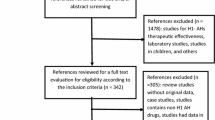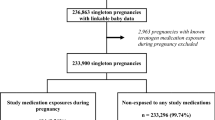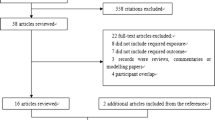Abstract
We aimed to study the association between use of antihistamines in early pregnancy and congenital heart defects (CHD) in the offspring. Design: Two case–control studies. Setting: HAVEN study, Erasmus MC, University Medical Centre, Rotterdam, and Eurocat Northern Netherlands (NNL), University Medical Center Groningen, Groningen, the Netherlands. We studied 361 children with CHD and 410 controls without congenital malformations from the HAVEN study and replicated the analyses in 445 children with CHD and 530 controls from the Eurocat NNL registry. Information about antihistamine use in early pregnancy and potential confounders was obtained from questionnaires postpartum. We calculated the association between antihistamines and CHD risk by multivariable logistic regression analysis. Main outcome measures: Odds ratios (OR) with 95 % confidence intervals (CI). In the HAVEN study, 25 of 771 mothers used antihistamines that were associated with an increased CHD risk (OR 3.0, 95 % CI 1.2–7.3), particularly atrioventricular septal defects (AVSD) (OR 5.1, 95 % CI 1.3–20.5) and perimembranous ventricular septal defects (pVSD) (OR 5.1, 95 % CI 1.8–14.4). Mothers with severe nausea who did not use antihistamines had a reduced risk (OR 0.7, 95 % CI 0.5–0.98), whereas nauseous mothers using antihistamines showed an almost fivefold increased risk of pVSD (OR 4.8, 95 % CI 1.1–21.8). The association between antihistamines and AVSD was confirmed in the Eurocat cohort (OR 3.5, 95 % CI 1.4–8.7), but we could not replicate the association with overall CHD risk. We found a positive association between antihistamine use in early pregnancy and CHD risk, particularly AVSD, which seemed to be independent of nausea/vomiting.
Similar content being viewed by others
References
Hoffman JI, Kaplan S. The incidence of congenital heart disease. J Am Coll Cardiol. 2002;39:1890–900.
Dolk H, Loane M, Garne E. Congenital heart defects in Europe: prevalence and perinatal mortality, 2000–2005. Circulation. 2011;123:841–9.
Yoon PW, Olney RS, Khoury MJ, Sappenfield WM, Chavez GF, Taylor D. Contribution of birth defects and genetic diseases to pediatric hospitalizations. A population-based study. Arch Pediatr Adolesc Med. 1997;151:1096–103.
Pierpont ME, Basson CT, Benson DW Jr, Gelb BD, Giglia TM, Goldmuntz E, et al. Genetic basis for congenital heart defects: current knowledge: a scientific statement from the American Heart Association Congenital Cardiac Defects Committee, Council on Cardiovascular Disease in the Young: endorsed by the American Academy of Pediatrics. Circulation. 2007;115:3015–38.
Jenkins KJ, Correa A, Feinstein JA, Botto L, Britt AE, Daniels SR, et al. Non-inherited risk factors and congenital cardiovascular defects: current knowledge: a scientific statement from the American Heart Association Council on Cardiovascular Disease in the Young: endorsed by the American Academy of Pediatrics. Circulation. 2007;115:2995–3014.
Rosenquist TH. Folate, homocysteine and the cardiac neural crest. Dev Dyn. 2013;242:201–18.
Botto LD, Correa A. Decreasing the burden of congenital heart anomalies: an epidemiologic evaluation of risk factors and survival. Progr Paediatr Cardiol. 2003;18:111–21.
Steegers-Theunissen RP, Steegers EA. Nutrient-gene interactions in early pregnancy: a vascular hypothesis. Eur J Obstet Gynecol Reprod Biol. 2003;106:115–7.
Dally A. Thalidomide: was the tragedy preventable? Lancet. 1998;351:1197–9.
Leeder JS, Spielberg SP, MacLeod SM. Bendectin: the wrong way to regulate drug availability. Can Med Assoc J. 1983;129:1085–7.
Einarson TR, Piwko C, Koren G. Quantifying the global rates of nausea and vomiting of pregnancy: a meta analysis. J Popul Ther Clin Pharmacol. 2013;20:e171–83.
Bakker MK, Jentink J, Vroom F, Van Den Berg PB, De Walle HE, De Jong-Van Den Berg LT. Drug prescription patterns before, during and after pregnancy for chronic, occasional and pregnancy-related drugs in the Netherlands. BJOG. 2006;113:559–68.
Narrod SA, Wilk AL, King CT. Metabolism of meclizine in the rat. J Pharmacol Exp Ther. 1965;147:380–4.
King CT, Weaver SA, Narrod SA. Antihistamines and teratogenicity in the rat. J Pharmacol Exp Ther. 1965;147:391–8.
Queißer-Luft A, Eggers I, Stolz G, Kieninger-Baum D, Schlaefer K. Serial examination of 20,248 newborn fetuses and infants: correlations between drug exposure and major malformations. Am J Med Genet. 1996;63:268–76.
Kallen B, Mottet I. Delivery outcome after the use of meclozine in early pregnancy. Eur J Epidemiol. 2003;18:665–9.
Weber-Schoendorfer C, Schaefer C. The safety of cetirizine during pregnancy. A prospective observational cohort study. Reprod Toxicol. 2008;26:19–23.
Seto A, Einarson T, Koren G. Pregnancy outcome following first trimester exposure to antihistamines: meta-analysis. Am J Perinatol. 1997;14:119–24.
Markl GE, Strunz-Lehner C, Egen-Lappe V, Hasford J. Prescribing patterns of anti-emetic drugs during.pregnancy in Germany. Arch Gynecol Obstet. 2007;275:461–7.
Verkleij-Hagoort AC, Verlinde M, Ursem NT, Lindemans J, Helbing WA, Ottenkamp J, et al. Maternal hyperhomocysteinaemia is a risk factor for congenital heart disease. BJOG. 2006;113:1412–8.
WHO Collaborating Centre for Drug Statistics Methodology. http://www.whocc.no/atcddd/. Accessed Sept 24 2008. http://www.icd9data.com/ and http://www.icd10data.com/ICD10CM/Codes.
Statistics Netherlands. Classification of educational level. Voorburg/Heerlen, the Netherlands, 2006. http://www.cbs.nl/menu/methoden/classificaties/overzicht/soi/default.htm. Accessed Nov 27, 2007.
Cogswell ME, Bitsko RH, Anderka M, Caton AR, Feldkamp ML, Hockett Sherlock SM, et al. Control selection and participation in an ongoing, population-based, case-control study of birth defects: the National Birth Defects Prevention Study. Am J Epidemiol. 2009;170:975–85.
Gilboa SM, Strickland MJ, Olshan AF, Werler MM, Correa A. The National Birth Defects Prevention Study. Use of antihistamine medications and isolated major malformations. Birth Defect Res Part A. 2009;85:137–50.
McKeigue PM, Lamm SH, Linn S, Kutcher JS. Bendectin and birth defects: I. A meta-analysis of the epidemiologic studies. Teratology. 1994;50:27–37.
Flaxman SM, Sherman PW. Morning sickness: a mechanism for protecting mother and embryo. Q Rev Biol. 2000;75:113–48.
Czeizel AE, Puhó E, Acs N, Bánhidy F. Inverse association between severe nausea and vomiting in pregnancy and some congenital abnormalities. Am J Med Genet A. 2006;140:453–62.
Huxley RR. Nausea and vomiting in early pregnancy: its role in placental development. Obstet Gynecol. 2000;95:779–82.
Simons FE. Advances in H1-antihistamines. N Engl J Med. 2004;351:2203–17.
Matsuyama K, Ichikawa T, Nitta Y, Ikoma Y, Ishimura K, Horio S, et al. Localized expression of histamine H1 receptors in syncytiotrophoblast cells of human placenta. J Pharmacol Sci. 2006;102:331–7.
Marino B, Vairo U, Corno A, Nava S, Guccione P, Calabro R, et al. Atrioventricular canal in Down syndrome. Prevalence of associated cardiac malformations compared with patients without Down syndrome. Am J Dis Child. 1990;144:1120–2.
Acknowledgments
We thank Professor W.A. Helbing, MD, PhD, Professor J. Ottenkamp, MD, PhD, and F.M.H. Siebel, MD, for their assistance in recruiting the case and control families. We are also grateful to Dr. M. Wildhagen, for data management and to Dr. A.C. Verkleij-Hagoort, Dr. L.M.J.W. van Driel and S. Borst for help in the data collection. We thank JL Senior for editing the final manuscript. The HAVEN study was financially supported by the Bo Hjelt Foundation (Grant 2005) and the Netherlands Heart Foundation (Grant 2002.B027). Eurocat NNL is funded by the Dutch Ministry of Health, Welfare and Sports.
Conflict of interest
There are no conflicts of interest to declare.
Ethical Standard
The study protocol was approved by the Central Committee of Research in Humans in The Hague, the Netherlands, and by the local Medical Ethics Committees of the four participating hospitals (CCMO07.1052/MA/P03.0200; MEC212.508/2002/91).
Author information
Authors and Affiliations
Corresponding author
Rights and permissions
About this article
Cite this article
Smedts, H.P.M., de Jonge, L., Bandola, S.J.G. et al. Early pregnancy exposure to antihistamines and risk of congenital heart defects: results of two case–control studies. Eur J Epidemiol 29, 653–661 (2014). https://doi.org/10.1007/s10654-014-9925-0
Received:
Accepted:
Published:
Issue Date:
DOI: https://doi.org/10.1007/s10654-014-9925-0




